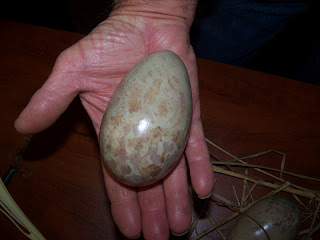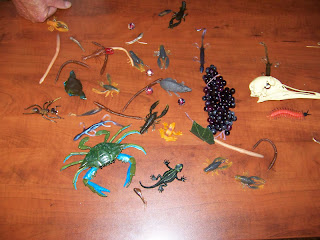These birds get HUGE. This life-sized photo shows just how huge: 5'2". They are the tallest flying birds on the planet. They have a wingspan of 7'. Because of their hollow bones, they only weigh 15-20 pounds. (I've roasted heavier turkeys!)
They sleep and nest in the water. This is a life-size model of a whooper egg. Two are laid. The one that hatches first, kills the second one--- unless humans intervene and take one and incubate it.
The babies grow and develop very fast, growing one inch per day and are able to stand and walk within a day of hatching.
Here is the display of some of what these omnivores consume with their 9" bill:
Apparently, blue crabs are a favorite and now that Texas is experiencing such drought there is concern that the blue crab population may be diminished as they depend on fresh water mixed with the salty Gulf water for their habitat.
A focus of the Operation Migration is to train fledglings to eat, drink, fly, and sleep by use of humans posing as mother cranes by using puppets such as you can see below.
The birds never see or hear the human. The visor is a one way mirror.

When the time is right, a group of 10 or so is trained to follow an ultralight plane with the pilot wearing the same outfit and a speaker playing recordings of their flight calls. They travel over seven states from Wisconsin to Florida, going about 50-60 miles per day at 38 mph, flying at 4,000 feet, up where it is very cold. The trip is 1,285 miles long.
Sadly, there was a complaint this year that led to an FAA investigation which grounded the birds in northern Alabama at Wheeler National Wildlife Refuge, near Decatur. The birds were kept there so long and they got so old, it was decided to abandon their trip. They will be released soon to return to Wisconsin (or wherever) on their own. The ones in Florida fly back on their own.
So we had heard in the class that two of the whoopers from last year's group had returned here for the winter on their own and had been spending time in an area near our home. A couple of evenings later, we went for a drive to see if we might find them ---and WE DID!!
What a thrill! There was an amateur photographer there who said she has been watching them for two weeks. I guess it is because these guys (and they are reportably both males as determined by their tracking bands) are about two years old, they do not look as tall as I expected them to. Of course we kept the distance.
 On Saturday, I was in the area and stopped back to see if they were still there. They had moved to another pond where there were no cows. These pictures are zoomed in 12 times and then cropped. I was not at all close to them. If you click on the pictures, you can see the red on their heads and also the leg bands that identify them.
On Saturday, I was in the area and stopped back to see if they were still there. They had moved to another pond where there were no cows. These pictures are zoomed in 12 times and then cropped. I was not at all close to them. If you click on the pictures, you can see the red on their heads and also the leg bands that identify them.In the water in the picture below are bufflehead ducks; Canada geese were on the shore.
What a thrill!
OK, guys: come spring, you head on back to Wisconsin and find you some gals and get busy making some babies. No pressure, but we are all counting on you! Bring them back here next fall.









No comments:
Post a Comment